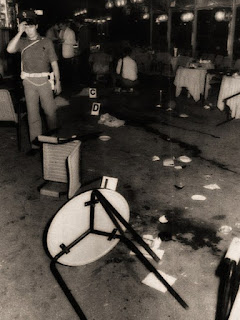Grenades thrown into iconic meeting place
The Café de Paris, a hang-out for Rome’s rich and famous during the 1950s and ‘60s and a symbol of the era encapsulated in Fellini’s classic film La dolce vita, was attacked by terrorists on this day in 1985.
A bloodstained pavement and upturned
tables and chairs after the attack
Tables outside the iconic venue, on the city’s fashionable Via Veneto, were packed with tourists on a busy evening when two grenades were thrown from a passing car or motorcycle.
One of the devices, of the classic type known as pineapple grenades, failed to explode, but the other did go off, injuring up to 39 people.
Although 20 were taken to hospital, thankfully most were released quickly after treatment for minor wounds. There were no fatalities and only one of those hospitalised, a chef who happened to be waiting on tables at the time of the attack, suffered serious injuries, from which he recovered.
Most of the victims were reported to be American, Argentine, West German or British tourists enjoying a late evening drink while taking in the atmosphere of Roman nightlife on a street lined with shops, cafés, airline offices and luxury hotels.
It was thought that three individuals carried out the attack but only one was apprehended and charged. While two of the attackers drove away at speed, Ahmad Hassan Abu Alì Sereya fled the scene on foot and was arrested by a policeman near Piazza Fiume, just under a kilometre away.
A 27-year-old born in Lebanon, Sereya claimed to be in Rome to buy clothes to resell on a market stall in Beirut.
 |
| The tree-lined Via Veneto was a symbol of wealth and luxury the mid-20th century Rome |
The motive for the attack was never fully established but it is thought the Café de Paris was chosen because of its proximity to the American Embassy in Rome. The date of the attack coincided with the third anniversary of the massacre of up to 3,000 Palestinians and Lebanese Shiites by Israeli-backed military and militia groups on the outskirts of Beirut in 1982.
The Café de Paris incident was one in a long sequence of Arab-linked terror attacks or planned attacks in Rome during the 1970s and ‘80s, the deadliest of which both occurred at the city’s Fiumicino airport.
In 1973, an attack carried out by five terrorists claimed 34 lives, including 29 passengers on a Pan American Airways plane that was stormed as it was waiting to take off.
In December 1985, just nine weeks after the Café de Paris incident, four attackers threw grenades and opened fire at the check-in desks of Israel's El Al Airline and the United States carrier Trans World Airlines, killing 12 travellers and an Israeli security officer.
Travel tip:
Fellini's classic movie La dolce vita was
filmed in the area around Via Veneto
Via Veneto, once one of Rome’s most elegant and expensive thoroughfares, is actually called Via Vittorio Veneto, named after the Battle of Vittorio Veneto, a decisive Italian victory of World War I, although the full name is rarely used. Among many exclusive shops, luxury hotels and bars, the Café de Paris was probably the most famous venue. The place to see and be seen in the 1950s and ‘60s, it was a magnet for visitors hoping to catch a glimpse of the film stars, models and other jet-setters who often occupied its tables. The bar was immortalised in Federico Fellini’s movie La dolce vita, starring Anita Ekberg, Anouk Aimée and Marcello Mastroianni, with many shots filmed there.
Travel tip
The shutters across the entrances to the Cafè
de Paris remain permanently closed
Anyone wanting to pay a nostalgic visit to the Café de Paris today will be disappointed. Although the beautiful wood and coloured glass of its frontage are still in place, and the Liberty framed glass display cases still contain black and white photographs of its famous ‘60s clientele, the doors are permanently shuttered up. The business went into decline in the later years of the 20th century and fell into the hands of mafia groups in the early part of this century, after which it was closed as part of a crackdown on money laundering. Located at No. 90 Via Veneto, close to the United States Embassy, it was revived by an anti-mafia co-operative, who served wine and food produced on land confiscated from crime gangs in southern Italy, but closed permanently in 2014 after the interior was destroyed in an arson attack.
Also on this day:
1797: The birth of British Museum librarian Sir Anthony Panizzi
1841: The birth of politician Alessandro Fortis
1866: The Sette e Mezzo Revolt in Palermo
2005: Camorra boss Paolo Di Lauro arrested
No comments:
Post a Comment